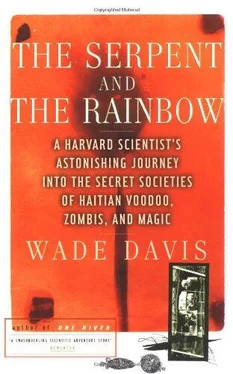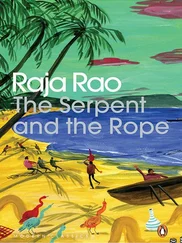Wade Davis - The Serpent and the Rainbow
Здесь есть возможность читать онлайн «Wade Davis - The Serpent and the Rainbow» весь текст электронной книги совершенно бесплатно (целиком полную версию без сокращений). В некоторых случаях можно слушать аудио, скачать через торрент в формате fb2 и присутствует краткое содержание. Год выпуска: 1985, Издательство: Simon & Schuster, Жанр: Старинная литература, на английском языке. Описание произведения, (предисловие) а так же отзывы посетителей доступны на портале библиотеки ЛибКат.
- Название:The Serpent and the Rainbow
- Автор:
- Издательство:Simon & Schuster
- Жанр:
- Год:1985
- ISBN:нет данных
- Рейтинг книги:5 / 5. Голосов: 1
-
Избранное:Добавить в избранное
- Отзывы:
-
Ваша оценка:
- 100
- 1
- 2
- 3
- 4
- 5
The Serpent and the Rainbow: краткое содержание, описание и аннотация
Предлагаем к чтению аннотацию, описание, краткое содержание или предисловие (зависит от того, что написал сам автор книги «The Serpent and the Rainbow»). Если вы не нашли необходимую информацию о книге — напишите в комментариях, мы постараемся отыскать её.
The Serpent and the Rainbow — читать онлайн бесплатно полную книгу (весь текст) целиком
Ниже представлен текст книги, разбитый по страницам. Система сохранения места последней прочитанной страницы, позволяет с удобством читать онлайн бесплатно книгу «The Serpent and the Rainbow», без необходимости каждый раз заново искать на чём Вы остановились. Поставьте закладку, и сможете в любой момент перейти на страницу, на которой закончили чтение.
Интервал:
Закладка:
It was a child that finally betrayed him, a young girl arrested along with three men as poisoners and condemned to be burned alive. One by one she was made to suffer the agonies of the others, watching the flames grow from the base of the pyre until they flared out of the acrid smoke to ignite the creosote-soaked rags. The smell of the flesh turned her stomach, and as she tried to look away they twisted her face to the sight and held it until she saw the belly of the men bloat, bubbling at the surface, dripping fluid until the skin, stretched to the limit, split, disgorging the steaming entrails of the gut. When her turn came, the executioner tormented her with the pinewood torch, tracing patterns in the air, brushing its burning end close to her skin. Her horror grew with her rage and fear, and just as the order was given, she broke, releasing the names of fifty others, which were dutifully recorded before the executioner, ignoring her cry of protest, went ahead and dropped the burning ember onto the base of the pyre.
The web of betrayal grew until it enveloped Macandal himself. But when his turn came, and he was paraded stripped to the waist before the people assembled in the capital, the citizens in their silk waistcoats beneath festive parasols, the slaves standing ebony black and solemn, the soldiers cautious, moving at the pace of death with the rhythm tapped out on drums covered in dark cloth, a strange thing happened. Macandal looked neither frightened nor even defiant as they lashed him to the post and brought forth the torch; he seemed indifferent, almost bored as he waited for the event, so carefully orchestrated by the governor, to be over. And when they saw him like that, a murmur ran through the ranks of the slaves, and their normally inscrutable expressions became radiant, expectant, disquieting to those whites sensitive enough to notice. Then, as the first flames reached the base of his legs, Macandal lifted his face, screaming at the sun. His body began to shake violently, his torso thrusting away from the post, his free stump pounding the air until with a single spasm that drew the breath out of the crowd he broke free and flung himself beyond the flames. Pandemonium broke over the mob. Amid calls of “Macandal is free!” the whites fled the plaza, and the guards rushed to the pyre, claiming later that they had recaptured the slave and bound him to a plank and cast him back onto the flames. But none of the blacks saw it done, and though the governor even produced the ashes to quell the fears of the whites, it was to little effect. The entire northern province, lulled into complacency by his capture, rang out with the alarm, and once again the planters felt like prisoners barricaded within their own houses. For the blacks there was little doubt as to what had occurred. If captured, Macandal had always told them, he would turn himself into a fly, and no one questioned his ability to do so, especially when after his reputed death, the toll of poison continued as before.
Macandal’s was not the first, nor certainly the last, Maroon revolt to shake the foundations of the colony. As early as 1681, before the colony had passed from the Spanish to the French and at a time when there were as many indentured whites as Africans, with a total population of only about six thousand, Maroonage was already an acknowledged threat. Two years before, in one of the earliest documented revolts, a slave named Padrejean had killed his master, recruited a band of twenty Africans, and embarked on his goal of strangling every white in the land. The revolt failed, but it was the type of incident that drew the attention of the king and led to the royal edict of 1685, a law that among other injunctions specified that a captured Maroon have his ears cut off and a shoulder branded with a fleur-de-lys; should the offense be repeated the hamstrings would be cut and a second brand applied to the other shoulder. The publication of this decree was an indication of a growing concern among the free whites, a fear that would become hysteria as the population of slaves soared. By the early years of the eighteenth century seditious plots, mysterious killings, and rumors of impending catastrophe became a staple of colonial life. Poisons were already so common that in 1738, two years before Macandal even fled the plantation, they were specifically prohibited by royal decree. Their political potential as a weapon of the slaves and a nefarious threat to the planters was made explicit upon the arrest of the Maroon leader Medor. “If the blacks commit poisonings,” he told his captors, “the end purpose is to gain freedom.”
By the last years of French rule, it was patently clear to all that the greed of the entire system had set the colony on a path of self-destruction. Only the potential for massive profits could possibly have numbed the whites to the imminent disaster. As absentee planters scrambled to increase their holdings, the borders of the plantations touched, and then to meet the rising demand for coffee, in particular, rose higher and higher into the mountains, displacing bands of Maroons and ironically forcing more and more of them to depend on pillage. The voracious consumption of labor, meanwhile, doubled the population of slaves in a mere fifteen years. How long could the whites possibly have expected to control close to a half-million blacks, the vast majority of them born in Africa and steeped in a military tradition of their own that had spread kingdoms across half a continent?
Like Macandal, the slaves plotted their final revolt with care. As their network spread and desertions swelled the ranks of the Maroons, the night air reverberated with the sounds of mutiny. In 1786 an informant reported clandestine meetings of two hundred or more slaves being held on the plantations. A contemporary document states “a great deal has been said of slave superstitions and of their secret organizations, and the scheming and crimes for which they provided pretext—poisonings, infanticide—… whites were not admitted to these secret meetings, and legal documentation was usually held secret or destroyed.”
From these nocturnal assemblies and within the passion of the vodoun rituals, the idea of liberty spread. Maroon bands grew in number as well as size, and the names of their leaders—Hyacinthe, Macaya, Romaine La Prophétesse—spread through the ranks of the slaves. The flash point came in the summer of 1791, and the spark was cast at a vodoun ceremony attended by delegates from every plantation on the northern plain.
The historic gathering was invoked by the Maroon leader Boukman Dutty, and held on a secluded knoll at Bois Caiman near Morne-Rouge. There on August 14, 1791, beneath the spindly branches of a frail acacia, with the wind twisting the ground and the jagged lightning crashing on all sides, an old woman stood transfixed by the night, quivering in the spasms of possession. The voices of Ogoun the Warrior, the god of fire and the metallurgical elements, called for the cutlass, and with a single blow severed the head and spilt the foamy blood of the black pig of Africa. The leaders were named—Boukman himself, Jean François, Biassou, and Celestin—and one by one the hundreds of slaves swore allegiance. Boukman stood up, and in a voice that matched the fury of the wind cried out, “God who made the sun that shines on us from above, who makes the sea to rage and the thunder roll, this same great God from his hiding place in the clouds, hear me, all of you, is looking down upon us. He sees what the whites are doing. The God of the whites asks for crime; ours desire only blessings. But this God who is so good directs you to vengeance! He will direct our arms, he will help us. Cast aside the image of the God of the whites who thirsts for our tears and pay heed to the voice of liberty speaking to our hearts.” Thus was sealed the pact of the final revolt, in the shadow of the loa and with the blood of the sacrifice.
Читать дальшеИнтервал:
Закладка:
Похожие книги на «The Serpent and the Rainbow»
Представляем Вашему вниманию похожие книги на «The Serpent and the Rainbow» списком для выбора. Мы отобрали схожую по названию и смыслу литературу в надежде предоставить читателям больше вариантов отыскать новые, интересные, ещё непрочитанные произведения.
Обсуждение, отзывы о книге «The Serpent and the Rainbow» и просто собственные мнения читателей. Оставьте ваши комментарии, напишите, что Вы думаете о произведении, его смысле или главных героях. Укажите что конкретно понравилось, а что нет, и почему Вы так считаете.












